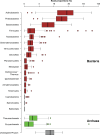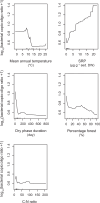Unravelling large-scale patterns and drivers of biodiversity in dry rivers
- PMID: 39174521
- PMCID: PMC11341732
- DOI: 10.1038/s41467-024-50873-1
Unravelling large-scale patterns and drivers of biodiversity in dry rivers
Abstract
More than half of the world's rivers dry up periodically, but our understanding of the biological communities in dry riverbeds remains limited. Specifically, the roles of dispersal, environmental filtering and biotic interactions in driving biodiversity in dry rivers are poorly understood. Here, we conduct a large-scale coordinated survey of patterns and drivers of biodiversity in dry riverbeds. We focus on eight major taxa, including microorganisms, invertebrates and plants: Algae, Archaea, Bacteria, Fungi, Protozoa, Arthropods, Nematodes and Streptophyta. We use environmental DNA metabarcoding to assess biodiversity in dry sediments collected over a 1-year period from 84 non-perennial rivers across 19 countries on four continents. Both direct factors, such as nutrient and carbon availability, and indirect factors such as climate influence the local biodiversity of most taxa. Limited resource availability and prolonged dry phases favor oligotrophic microbial taxa. Co-variation among taxa, particularly Bacteria, Fungi, Algae and Protozoa, explain more spatial variation in community composition than dispersal or environmental gradients. This finding suggests that biotic interactions or unmeasured ecological and evolutionary factors may strongly influence communities during dry phases, altering biodiversity responses to global changes.
© 2024. The Author(s).
Conflict of interest statement
The authors declare no competing interests.
Figures





References
-
- Sánchez-Bayo, F. & Wyckhuys, K. A. G. Worldwide decline of the entomofauna: a review of its drivers. Biol. Conserv.232, 8–27 (2019). 10.1016/j.biocon.2019.01.020 - DOI

